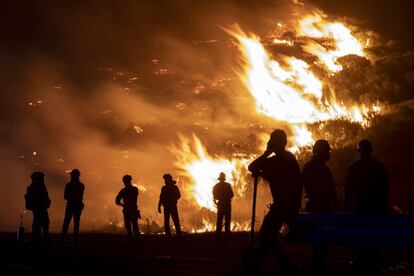Half of Spain’s towns at high risk of forest fires
Experts say that when it comes to development, economic interests have been prioritized over safety, particularly in coastal areas of the country

At least 46.35% of Spain’s 8,131 municipalities are located in areas at high risk of forest fires, according to fire prevention and firefighting plans and documents from Spain’s regions. This conclusion has been reached by EL PAÍS after compiling data on the total number of towns located in high fire risk areas throughout Spain, apart from the regions of Navarre and the Basque Country, which do not provide official figures. The 2003 Forestry Law defines these high-risk zones as “areas in which the frequency or virulence of forest fires and the importance of what is threatened make special fire protection measures necessary.”
According to the 2003 Forestry Law, the 3,769 municipalities affected plus the property owners within them must have a fire prevention plan with protocol agreed upon by the corresponding region. However, 75% of these towns in high-risk areas lack such a plan, according to the report Protect the Forest, Protect Your Home, published by the environmental group Greenpeace in 2018.
According to David Caballero, an international consultant on forest fire risks who participated in the report, “All along the Spanish coastline, buildings and forests have been mixed together because of its tourist appeal. But there is a serious risk of being hit by a catastrophe like the one in Mati, Greece.” In that instance, fires destroyed dozens of homes and caused more than 100 deaths in the summer of 2018. Oskar Karlsson, environmentalist and member of the Forest Geography, Policy and Socioeconomics group at Madrid’s Complutense University, confirms the risk homes in such areas are exposed to. “They have been built using architects, but without geographers, and with economic interest taking precedence,” he says. “If we were a rich country, we would demolish them all.”
Spain’s regions should ensure that the at-risk municipalities approve a specific fire prevention plan. However, there is no public information available on whether the towns in question are complying or not. The latest Greenpeace report indicates that only 1,023 localities comply, which is just 25% of the total number located in high-risk areas. Municipalities must also ensure that all property owners within these districts have a protocol to protect themselves from fires. But there is no record of that either.
We have inherited tremendous urban development from the 1970s, 1980s and 1990s, prior to any fire-conscious regulationsDavid Caballero, international consultant on forest fire risks
Karlsson says he is “not surprised” as “municipal policy is very slow.” He also flags up the problem posed by the fact that powers relating to forestry affairs are devolved to Spain’s 17 regions. “We have 17 different environmental departments and a different forestry plan for each one,” he says. “If the administration were more centralized, it would be much easier to make a prevention and land management policy.”
In 2003, preventive plans were made mandatory for town councils and property owners in high-risk areas, but there had already been a great deal of development by then. “We have inherited tremendous urban development from the 1970s, 1980s and 1990s, prior to any fire-conscious regulations,” says Caballero. “And now we have hundreds of thousands of vulnerable houses.” In the Ibizan town of Santa Eulalia del Río alone, the estimated number of houses in at-risk areas exceeds 11,000 in a population of 39,358, according to Caballero, who was in charge of counting each individual home.
Cristina Montiel, professor of Geography at the Complutense University of Madrid, explains that in Spain “there is a lack of land-use plans to protect against the risk of fire and to prevent the urbanization of certain areas.” But she insists there are significant discrepancies between regions. “In Madrid, there is not even a land management plan, whereas one does exist in the Balearic Islands and it’s very well put together.”
Of all Spain’s regions, Castilla-La Mancha is the one with the most municipalities in high fire-risk areas, with a total of 780.
Tu suscripción se está usando en otro dispositivo
¿Quieres añadir otro usuario a tu suscripción?
Si continúas leyendo en este dispositivo, no se podrá leer en el otro.
FlechaTu suscripción se está usando en otro dispositivo y solo puedes acceder a EL PAÍS desde un dispositivo a la vez.
Si quieres compartir tu cuenta, cambia tu suscripción a la modalidad Premium, así podrás añadir otro usuario. Cada uno accederá con su propia cuenta de email, lo que os permitirá personalizar vuestra experiencia en EL PAÍS.
¿Tienes una suscripción de empresa? Accede aquí para contratar más cuentas.
En el caso de no saber quién está usando tu cuenta, te recomendamos cambiar tu contraseña aquí.
Si decides continuar compartiendo tu cuenta, este mensaje se mostrará en tu dispositivo y en el de la otra persona que está usando tu cuenta de forma indefinida, afectando a tu experiencia de lectura. Puedes consultar aquí los términos y condiciones de la suscripción digital.
More information
Últimas noticias
Raúl Rocha, from jet-setting with Miss Universe to arms trafficking and fuel theft
80,000 barrels of Mexican oil sent to Cuba: Havana drawn into the US–Mexico clash
Human rights activists, opposition members, and a minor: Maduro’s other political prisoners
Israel sparks a civil war within the MAGA movement
Most viewed
- Reinhard Genzel, Nobel laureate in physics: ‘One-minute videos will never give you the truth’
- Pablo Escobar’s hippos: A serious environmental problem, 40 years on
- Charles Dubouloz, mountaineering star, retires at 36 with a farewell tour inspired by Walter Bonatti
- Why we lost the habit of sleeping in two segments and how that changed our sense of time
- The fall of a prolific science journal exposes the billion-dollar profits of scientific publishing











































